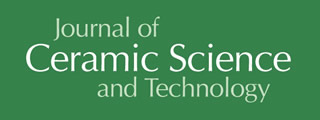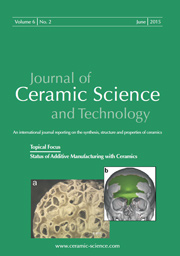Articles
All articles | Recent articles
Porous Geopolymer Components through Inverse Replica of 3D Printed Sacrificial Templates
G. Franchin1, P. Colombo1,2
1 Department of Industrial Engineering, University of Padova, Via Marzolo 9, 35131 Padova, Italy
2 Department of Materials Science and Engineering, The Pennsylvania State University, University Park, PA 16801, USA
received December 29, 2014, received in revised form February 2, 2015, accepted February 26, 2015
Vol. 6, No. 2, Pages 105-112 DOI: 10.4416/JCST2014-00057
Abstract
Geopolymeric components with high controlled porosity were designed and produced by means of CAD/CAM and FDM (Fused Deposition Modeling) techniques. PLA sacrificial structures with different patterns were 3D printed with high accuracy and a geopolymeric slurry was used to produce close inverse replicas by means of impregnation in vacuum conditions and subsequent geopolymerization reaction and template removal in a combined chemical and thermal treatment. The FDM-manufactured sacrificial structures replicated the computationally designed porosity to be obtained in the final geopolymer components in terms of total porosity, average pore size and pore architecture. Geopolymer features were not affected by the fabrication route, and the process resulted in highly porous geopolymeric components with well-defined interconnected channels designed at both the macro- and microscopic scale. The specific surface area of the samples was ∼ 23 m2/g. The total porosity of the samples ranged from ∼ 66 to ∼ 71 vol%, given both by the designed geometrical macroporosity and by the inherent chemical micro- and meso-porosity of the geopolymer.
![]() Download Full Article (PDF)
Download Full Article (PDF)
Keywords
Geopolymers, solid freeform fabrication, fused deposition modeling, inverse replica, 3D printing
References
1 Hull, W.C.: Apparatus for production of three-dimensional objects by stereolithography, US 06/638,905, (1984).
2 Yang, S., Leong, K., Du, Z., Chua, C.: The design of scaffolds for use in tissue engineering. Part II: Rapid prototyping techniques, Tissue Eng., 8, [1], 1 – 11, (2002).
3 Bertsch, A., Bernhard, P., Vogt, C., Renaud, P.: Rapid prototyping of small size objects, Rapid Prototyping J., 6, 259 – 266, (2000).
4 Abe, F., Osakada, K., Shiomi, M., Uematsu, K., Matsumoto, M.: The manufacturing of hard tools from metallic powders by selective laser melting, J. Mater. Process. Tech., 111, 210 – 213, (2001).
5 Agarwala, M., Bourell, D., Beaman, J., Marcus, H., Barlow, J.: Direct selective laser sintering of metals, Rapid Prototyping J., 1, 26 – 36, (1995).
6 Atzeni, E., Salmi, A.: Economics of additive manufacturing for end-usable metal parts, Int. J. Adv. Manuf. Tech., 62, 1147 – 1155, (2012).
7 Brandl, E., Baufeld, B., Leyens, C., Gault, R.: Additive manufactured Ti-6Al-4V using welding wire: comparison of laser and arc beam deposition and evaluation with respect to aerospace material specifications, Physics Procedia, 5, Part B, 595 – 606, (2010).
8 Lewis, J.A.: Direct-write assembly of ceramics from colloidal inks, Curr. Opin. Solid St. M., 6, 245 – 250, (2002).
9 Travitzky, N., Bonet, A., Dermeik, B., Fey, T., Filbert-Demut, I., Schlier, L., Schlordt, T., Greil, P.: Additive manufacturing of ceramic-based materials, Adv. Eng. Mater., 16, 729 – 754, (2014).
10 Schlordt, T., Schwanke, S., Keppner, F., Fey, T., Travitzky, N., Greil, P.: Robocasting of alumina hollow filament lattice structures, J. Eur. Ceram. Soc., 33, 3243 – 3248, (2013).
11 Mühler, T., Gomes, C.M., Heinrich, J., Günster, J.: Slurry-based additive manufacturing of ceramics, Int. J. Appl. Ceram. Tec., 12, 18 – 25, (2015).
12 Bose, S., Avila, M., Bandyopadhyay, A.: Processing of bioceramic implants via fused deposition process. In: '98 SFF. Austin, TX., 1998.
13 Zhang, R., Ma, P.X.: Synthetic nano-fibrillar extracellular matrices with predesigned macroporous architectures, J. Biomed. Mater. Res., 52, 430 – 438, (2000).
14 Ma, P.X.: Scaffolds for tissue fabrication, Mater. Today, 7, 30 – 40, (2004).
15 Lee, M., Dunn, J.C.Y., Wu, B.M.: Scaffold fabrication by indirect three-dimensional printing, Biomaterials, 26, 4281 – 4289, (2005).
16 Chen, V.J., Smith, L.A., Ma, P.X.: Bone regeneration on computer-designed nano-fibrous scaffolds, Biomaterials, 27, 3973 – 3979, (2006).
17 Strozi Cilla, M., Morelli, M.R., Colombo, P.: Open cell geopolymer foams by a novel saponification/peroxide/gelcasting combined route, J. Eur. Ceram. Soc., 34, 3133 – 3137, (2014).
18 Coszach, P., Bogaert, J., Willocq, J.: Chemical recycling of PLA by hydrolysis, PCT/EP2010/054274, (2010).
19 Davidovits, J.: Geopolymers, J. Therm. Anal. Calorim., 37, 1633 – 1656, (1991).
20 Okada, K., Imase, A., Isobe, T., Nakajima, A.: Capillary rise properties of porous geopolymers prepared by an extrusion method using polylactic acid (PLA) fibers as the pore formers, J. Eur. Ceram. Soc., 31, 461 – 467, (2011).
21 Bignozzi, M.C., Manzi, S., Lancellotti, I., Kamseu, E., Barbieri, L., Leonelli, C.: Mix-design and characterization of alkali activated materials based on metakaolin and ladle slag, Appl. Clay. Sci., 73, 78 – 85, (2013).
22 Davidovits, J.: Geopolymer chemistry and applications. 3rd edition. Institute Géopolymère, Saint-Quentin, 2011.
23 Bell, J.L., Driemeyer, P.E., Kriven, W.M.: Formation of ceramics from metakaolin-based geopolymers. Part II: K-based geopolymer, J. Am. Ceram. Soc., 92, 607 – 615, (2009).
24 Duxson, P., Lukey, G., van Deventer, J.J.: Physical evolution of Na-geopolymer derived from metakaolin up to 1000 °C, J. Mater. Sci., 42, 3044 – 3054, (2007).
25 Li, L., Wang, S., Zhu, Z.: Geopolymeric adsorbents from fly ash for dye removal from aqueous solution, J. Colloid Interf. Sci., 300, 52 – 59, (2006).
26 Cheng, T.W., Lee, M.L., Ko, M.S., Ueng, T.H., Yang, S.F.: The heavy metal adsorption characteristics on metakaolin-based geopolymer, Appl. Clay. Sci., 56, 90 – 96, (2012).
27 Medpelli, D., Seo, J., Seo, D.: Geopolymer with hierarchically Meso-/Macroporous structures from reactive emulsion templating, J. Am. Ceram. Soc., 97, 70 – 73, (2014).
28 Strozi Cilla, M., Raymundo Morelli, M., Colombo, P.: Effect of process parameters on the physical properties of porous geopolymers obtained by gelcasting, Ceram. Int., 40, 13585 – 13590, (2014).
Copyright
Göller Verlag GmbH


